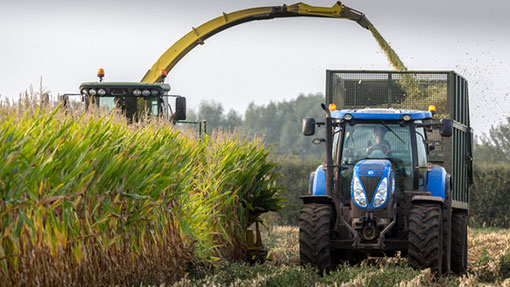Hold back maize harvest for optimal starch levels

The temptation to start harvesting this autumn’s maize too soon could jeopardise the crop’s starch levels – even though crops look advanced and ground conditions are ideal.
That’s the advice of agronomists as farmers in the North gear up to start harvesting what promises to be a bumper maize crop, with yields expected to hit 50t/ha.
“This crop has been more advanced all the way through the growing season. We’ve not seen maize like this for many years,” says Shropshire maize specialist Ian Grandfield of Green Gem Agriculture.
“Vital stages of important growth were achieved in the summer months when daylight hours were at their longest and it has meant crops have developed much earlier.”
Mr Grandfield says some farmers had expected crops to look even bulkier than they do following the near-perfect growing season, but says a lot of this season’s maize promises to give its biggest pay-off in terms of its starch levels.
“There are a few crops that may not look just as big as last year, but overall we’re expecting to see high starch production at about 30%.”
While some maize crops in the South East are already in the clamp, harvesting is expected to start in other regions this week.
“Some crops could even produce starch levels heading towards 35%, but the ideal combination of 30% starch and 30% dry matter should be on the cards for many growers.”
But while advisers appreciate the dry ground conditions will encourage many to start harvesting as soon as possible, they are reminding growers that maize starch levels continue to improve with maturity at this time of year.
“Maturity has the biggest effect on starch levels. Cobs can look enormous but they may not be fully developed. Starch is not laid down by the crop all through its development, but at this time of year the plants are developing starch at a massive rate.
“To harvest two weeks before the crop is really ready could mean depriving it of its optimum starch yield and losing out on a significant starch percentage. If the grain is still carrying water, there’s no starch in water,” says Mr Grandfield.
Grainseed’s Neil Groom advises growers to harvest drier-looking crops first and clamp greener crop on top. If any juice comes out, it is absorbed by the dry maize,” he says.
Processing
Dairy nutritionist Hefin Richards says cob development this season is “very forward”.
“We will get good, mature grain from these cobs, but it’s essential to have a high standard of processing.
“Good processing of maize is absolutely critical this season where crops are mature and have a high grain content,” says Mr Richards of Profeed Nutrition.
But he adds the sheer bulk of this year’s crop could cause storage problems on some farms. “It’s pointless to overfill clamps and end up with a lot more wastage.
“Farmers will do a lot better if they decide to cut the crop higher to ensure only the highest feed value material is ensiled. They can leave about one foot of low-feed-value stem in the field instead of trying to clamp what is little more that gut-fill.”
